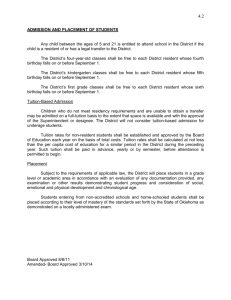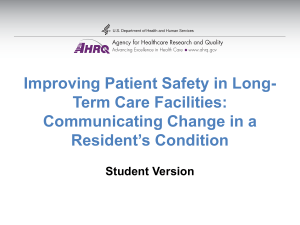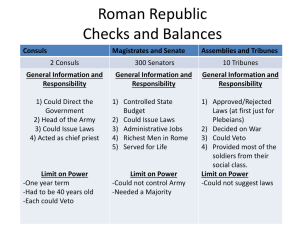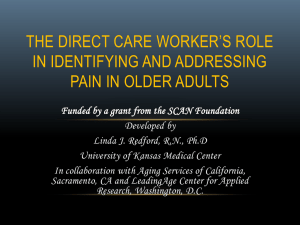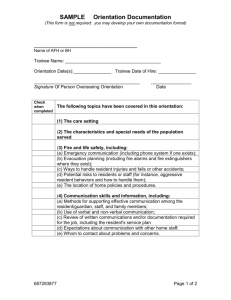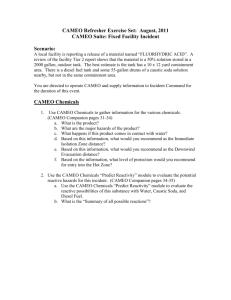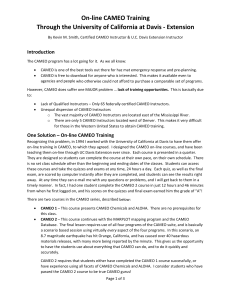Clinical Assessment and Management Examination
advertisement
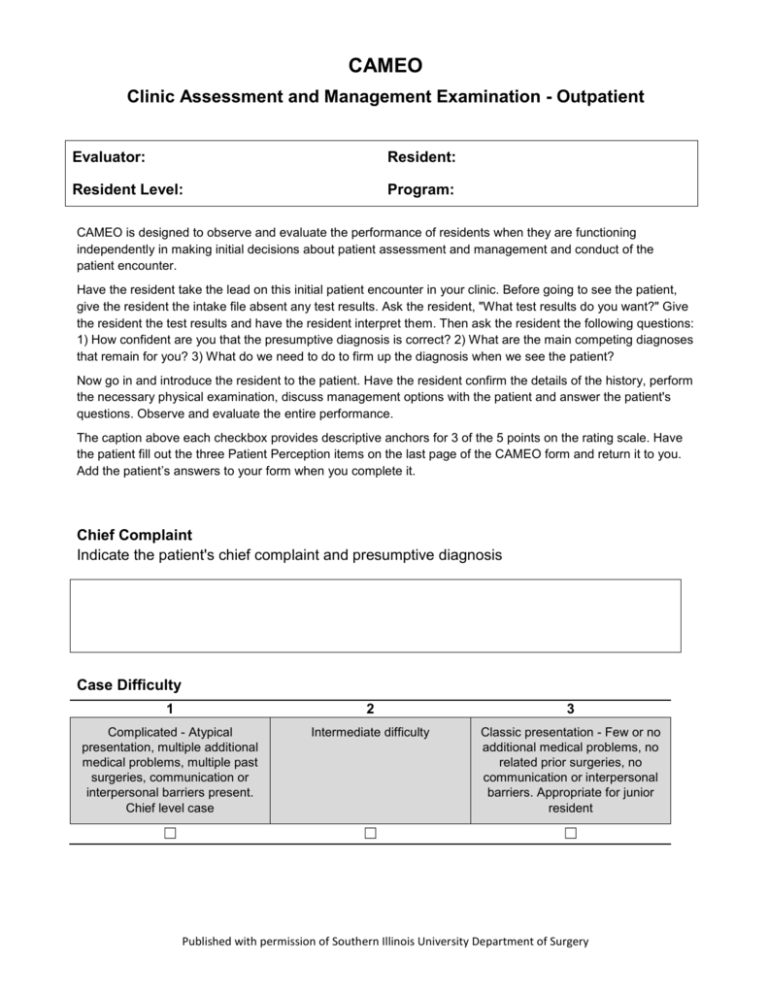
CAMEO Clinic Assessment and Management Examination - Outpatient Evaluator: Resident: Resident Level: Program: CAMEO is designed to observe and evaluate the performance of residents when they are functioning independently in making initial decisions about patient assessment and management and conduct of the patient encounter. Have the resident take the lead on this initial patient encounter in your clinic. Before going to see the patient, give the resident the intake file absent any test results. Ask the resident, "What test results do you want?" Give the resident the test results and have the resident interpret them. Then ask the resident the following questions: 1) How confident are you that the presumptive diagnosis is correct? 2) What are the main competing diagnoses that remain for you? 3) What do we need to do to firm up the diagnosis when we see the patient? Now go in and introduce the resident to the patient. Have the resident confirm the details of the history, perform the necessary physical examination, discuss management options with the patient and answer the patient's questions. Observe and evaluate the entire performance. The caption above each checkbox provides descriptive anchors for 3 of the 5 points on the rating scale. Have the patient fill out the three Patient Perception items on the last page of the CAMEO form and return it to you. Add the patient’s answers to your form when you complete it. Chief Complaint Indicate the patient's chief complaint and presumptive diagnosis Case Difficulty 1 2 3 Complicated - Atypical presentation, multiple additional medical problems, multiple past surgeries, communication or interpersonal barriers present. Chief level case Intermediate difficulty Classic presentation - Few or no additional medical problems, no related prior surgeries, no communication or interpersonal barriers. Appropriate for junior resident ☐ ☐ ☐ Published with permission of Southern Illinois University Department of Surgery CAMEO – Page 2 Test Ordering and Understanding 5 Excellent 4 Very Good Recommended tests and procedures that were clearly indicated by the findings; avoided over-ordering of tests; gave appropriate and clear instructions (e.g., fasting instructions) to patient to assure proper test administration and interpretation ☐ 3 Good 2 Fair Recommended tests and procedures that were generally appropriate, though some were marginally useful. Little awareness of cost/benefits ☐ ☐ 1 Poor NA Tests recommended were not sufficient or appropriate for this patient. Resident had poor concept of test utility or cost/benefit for this patient ☐ ☐ ☐ 2 Fair 1 Poor NA Diagnostic Acumen 5 Excellent 4 Very Good Recognizes symptom patterns; includes appropriate alternatives in differential; efficient in pulling together information to confirm the diagnosis; takes appropriate steps to confirm the diagnosis ☐ 3 Good Recognizes obvious symptom patterns; reasonably efficient in pulling together information to confirm the diagnosis; misses some less obvious signs and symptoms ☐ ☐ Fails to recognize clinically obvious conditions; grossly inefficient in pulling together information to confirm the diagnosis; misjudges severity of patient condition ☐ ☐ ☐ 1 Poor NA History Taking 5 Excellent 4 Very Good Precise, logical, purposeful and efficient; skillful at checking understanding of the findings ☐ 3 Good 2 Fair Missing some minor facts but relatively precise, logical, purposeful and efficient ☐ ☐ Missing important information, inefficient, disorganized; failed to check understanding of results ☐ ☐ ☐ CAMEO – Page 3 Physical Examination 5 Excellent 4 Very Good Excellent techniques, appropriately thorough, efficient, perceptive in picking up key signs 3 Good 2 Fair Good technique, reasonably efficient, omitted a few important elements, missed some signs ☐ 1 Poor NA Poor technique, grossly inefficient, omitted key elements, missed some key signs, poor attention to patient modesty ☐ ☐ ☐ ☐ ☐ 4 Very Good 3 Good 2 Fair 1 Poor NA Communication Skills 5 Excellent Explained presumed diagnosis and management appropriately using vocabulary appropriate to the patient; established excellent rapport with patient; professional at all times; answered patient's questions clearly and accurately Explanation of presumed diagnosis and management were generally appropriate and free of medical jargon; appropriately empathic; professional at all times; answers to patient questions were generally clear and accurate ☐ ☐ ☐ Explanation of presumed diagnosis and management were incorrect, missing or incomprehensible, poor rapport with patient, unprofessional at times, answers to patient questions were confusing or incorrect ☐ ☐ ☐ Overall Performance 5 – Clearly superior performance, 3 – Competent performance, 1 – Poor performance 5 4 3 2 1 Excellent Very Good Good Fair Poor NA ☐ ☐ ☐ ☐ ☐ ☐ Overall Comments: CAMEO – Page 4 CAMEO Patient Perceptions of Resident Clinical Performance and Professional Behavior Have the patient complete the following three items and return it to you. Transfer their answers to your form. 5 – Excellent, 4 – Very Good, 3 – Good, 2 – Fair, 1 – Poor 1) The resident listened to me, encouraged me to ask questions and took time to answer my questions. 5 Excellent 4 Very Good 3 Good 2 Fair 1 Poor ☐ ☐ ☐ ☐ ☐ 2) The resident's explanations about your medical problem, care, treatment and medications. 5 Excellent 4 Very Good 3 Good 2 Fair 1 Poor ☐ ☐ ☐ ☐ ☐ 3) The interest, courtesy and respect shown by the resident. 5 Excellent 4 Very Good 3 Good 2 Fair 1 Poor ☐ ☐ ☐ ☐ ☐

